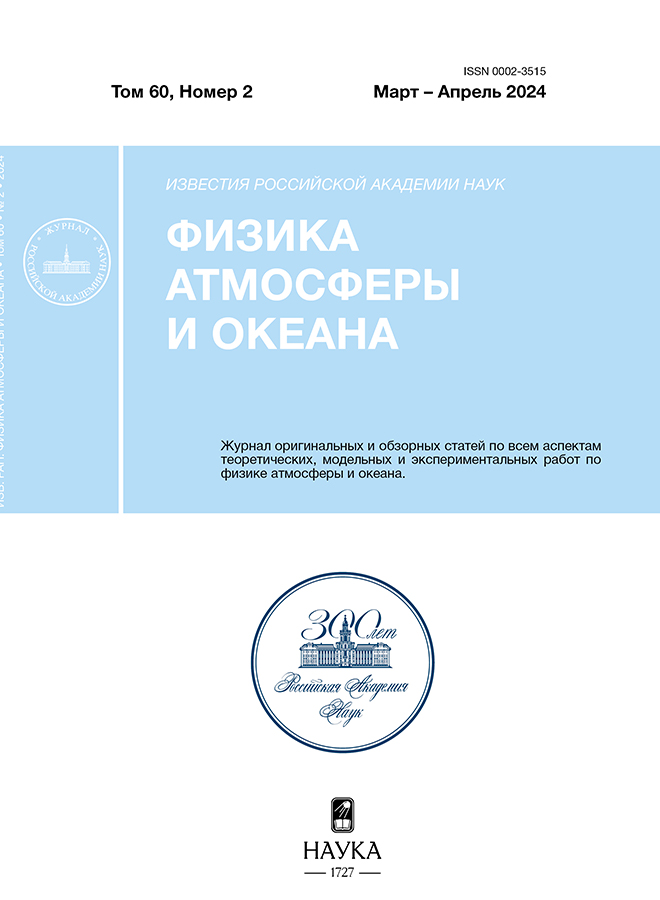On the рossibility of multichannel optical backscattering sondes for joint balloon and lidar studies of the aerosol composition of the middle atmosphere
- 作者: Balugin N.V.1, Fomin B.A.1, Yushkov V.А.1, Marichev V.N.2, Bochkovskyi D.A.2
-
隶属关系:
- Central Aerological observatory
- Zuev Institute of Atmospheric Optics RAS SB
- 期: 卷 60, 编号 2 (2024)
- 页面: 246–251
- 栏目: Articles
- URL: https://journals.eco-vector.com/0002-3515/article/view/658360
- DOI: https://doi.org/10.31857/S0002351524020104
- EDN: https://elibrary.ru/KPJSVM
- ID: 658360
如何引用文章
详细
Aerosol backscattering sondes in the practice of aerological sounding, along with lidar observations, are used at night to study and monitor polar stratospheric clouds, tropospheric and stratospheric aerosol, cirrus clouds, pyroconvection, volcanic aerosol, as well as to verify remote methods and means of ground-based and satellite-based aerosol observations. For aerosol sondes, a simple two-wave measurement technique is used, which makes it possible to diagnose changes in aerosol composition by color index. The possibilities of the two-wave technique have limitations, which are discussed in this article. Aerological sounding combined with lidar observations expands the wavelength range for multi-wavelength studies, and direct measurements of atmospheric temperature increase the accuracy of aerosol sensing. The paper considers the application of 3 or more wavelenght techniques. Data from probe measurements using wavelengths of 470, 528, 850 and 940 nm and lidar sensing at wavelengths of 355 and 532 nm are presented.
全文:
作者简介
N. Balugin
Central Aerological observatory
Email: v_yushkov@mail.ru
俄罗斯联邦, 14170, Dolgoprudny, Moscow Region, Pervomayskaya str., 3
B. Fomin
Central Aerological observatory
Email: v_yushkov@mail.ru
俄罗斯联邦, 14170, Dolgoprudny, Moscow Region, Pervomayskaya str., 3
V. Yushkov
Central Aerological observatory
编辑信件的主要联系方式.
Email: v_yushkov@mail.ru
俄罗斯联邦, 14170, Dolgoprudny, Moscow Region, Pervomayskaya str., 3
V. Marichev
Zuev Institute of Atmospheric Optics RAS SB
Email: v_yushkov@mail.ru
俄罗斯联邦, 634055, Tomsk, Ak. Zueva place, 1
D. Bochkovskyi
Zuev Institute of Atmospheric Optics RAS SB
Email: v_yushkov@mail.ru
俄罗斯联邦, 634055, Tomsk, Ak. Zueva place, 1
参考
- Балугин Н.В., Фомин Б.А., Юшков В.А. Оптический зонд обратного рассеяния для баллонных аэрологических измерений // Изв. РАН. Физика атмосферы и океана. 2022. Т. 58. № 3. С. 1–8.
- Балугин Н.В., Фомин Б.А., Лыков А.Д., Юшков В.А. Фомин Б.А. Оценка воздействия стратосферного аэрозоля на радиационный баланс стратосферы по данным оптического баллонного зонда обратного рассеяния и радиационного моделирования // Метеорология и гидрология. 2022. № 10. С. 121–129.
- Г. ван де Хюлст. Рассеяние света малыми частицами. М.: Издательство иностранной литературы, 1961. 536 с.
- Зуев В.В. Лидарный контроль стратосферы. Новосибирск: Наука, 2004. 306 с.
- Маричев В.Н., Бочковский Д.А. Лидарный комплекс малой станции высотного зондирования атмосферы ИОА СО РАН // Оптика атмосферы и океана. 2020. Т. 33. № 5. С. 399–406. https://doi.org/10.15372/AOO20200510
- Маричев В.Н., Матвиенко Г.Г., Юшков В.А., Балугин Н.В., Бочковский Д.А. Лидарно-баллонный эксперимент по исследованию стратосферного аэрозоля для климатических наблюдений и диагностических задач // Метеорология и гидрология. 2022. № 11. С. 41–47.
- Brabec M., Wienhold F.G., Luo B.P., Vomel H., Immler F., Steiner P., Hausammann E., Weers U., Peter T. Particle backscatter and relative humidity measured across cirrus clouds and comparison with microphysical cirrus modeling // Atmos. Chem. Phys. 2012. № 12. P. 9135–9148. https://doi.org/10.5194/acp-12-9135-2012
- Blake D.F., Kato K. Latitudinal distribution of black carbon soot in the upper troposphere and lower stratosphere // J. Geophys. Res. 1995. V. 100. № D4. P. 7195–7202.
- Fomin B.A., Mazin I.P. Model for an investigation of radiative transfer in cloudy atmosphere // Atmospheric Research. 1998. V. 47–48. P. 127–153.
- Rosen J.M., Kjome N.T. Backscattersonde: a new instrument for atmospheric aerosol research. APPLIED OPTICS. 1991. V. 30. № 12. Р 1552–1561.
- Zhang Y. et al. Top-of-atmosphere radiative forcing affected by brown carbon in the upper troposphere // Nature geoscience, advance online publication, published online: 22 may 2017. https://doi.org/10.1038/ngeo2960WCP-112
- A preliminary cloudless standard atmosphere for radiation calculation // World Climate Research Program. WMO/TD, 1986. 66 p.
补充文件

注意
1The article is based on the oral report presented at the IV All-Russian Conference with international participation “Turbulence, atmospheric dynamics and climate”, dedicated to the memory of academician A.M. Obuhova (Moscow, November 22–24, 2022).











